|
| |
|
9th International
System-on-Chip (SoC)
Conference, Exhibit & Workshops
November 2 & 3, 2011
—
Radisson Hotel Newport Beach, California
SoC Conference Presenters'
Bios & Abstracts
|
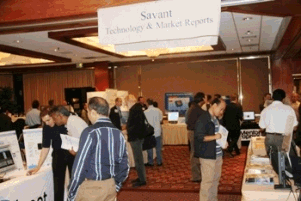 |
|
If you
have any questions or need more information, please contact:
SoC@SavantCompany.com
or
949-851-1714 ― Thank
you!
a
|
|
* Program is subject to change.
SoC Conference Organizing Committee, Technical Advisory Board (TAB), and Savant Company Inc. reserves the rights to revise or modify the
SoC Conference program at
its sole discretion.
|
|
|
|
|
|
|
|
|
Day
One Nov. 2, 2011
SoC Conference Program Agenda* |
|
|
|
Savant
Company Inc.
 |
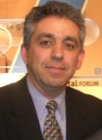 Farhad
Mafie, SoC Conference Chairman, Savant Company Inc., President & CEO,
IEEE OC SSCS & OCEN Chairs. Farhad
Mafie, SoC Conference Chairman, Savant Company Inc., President & CEO,
IEEE OC SSCS & OCEN Chairs.
"Welcome and Opening Remarks, Technology/Market Trends."
Farhad Mafie is President and
CEO of Savant Company Inc., a technology marketing company in Irvine, CA.
Savant specializes in marketing and sales of semiconductor IC/IP products,
SoC/ASIC services and solutions, as well as providing targeted technical-
and business-related training seminars and conferences globally. He has over
20 years of experience in semiconductor and computer businesses and more
than 10 years of university-level teaching experience. He is the former Vice
President of Marketing and Engineering at Toshiba Semiconductor. He has also
worked in strategic marketing, project and design engineering at Lucent
Technologies, Unisys, and MSI Data. Farhad has a Master of Science and a
Bachelor of Science degree in Electronic Engineering from California State
University, Fullerton. He is an author and a translator, and his articles
have been published in a variety of journals and Web-based magazines on
technology and political affairs. In 2003, he published the biography of
Iranian poet and Nobel nominee who lived in exile, Nader Naderpour
(1929-2000), Iranian Poet, Thinker, Patriot. Farhad is also Editor-in-Chief
for the CRC Press SoC Design and Technologies Book Series, which includes
(1) Low-Power NoC for High-Performance SoC Design and (2) Design of
Cost-Efficient Interconnect Processing Units. Farhad is an active member of
IEEE, and he is the chair of IEEE Orange County Solid-State Circuits Society
(SSCS), as well as IEEE Orange County Entrepreneurs' Network (OCEN). He is
also a member of two UCI Advisory Committees: Communication System
Engineering and Embedded System Engineering Certificate Programs.
|
|
|
|
|
SOI vs. CMOS for Analog
& Digital Circuits – Technology, Trends, Challenges, and Emerging
Applications.
Track Chairman: Dr. Nader Bagherzadeh, Professor
Electrical & Computer Engineering, UC Irvine.
|
|
|
|
X-Fab
 |
 Paul Poenisch and
Sebastian Schmidt. X-FAB. Paul Poenisch and
Sebastian Schmidt. X-FAB.
SOI technologies at X-FAB and their application space.
Abstract: X-FAB has a long
history in providing SIO technologies. The earliest SOI technologies have
1µm minimum feature size. They are, however, quite different in process
feature and voltage range. As examples may serve the XD10, enabling a
voltage range up to about 700V, which isolation is achieved through deep
trenches. The etching technology for these trenches has enhanced over the
years and nowadays provides a significant contribution to the MEMS
technologies of X-FAB. Trench isolation is also used by the XT06 with 0.6µm
minimum feature size, bearing medium voltage (60V) devices, and the XT018
with 0.18µm minimum feature size, providing up to 200V and low voltage
devices at around 20V. Of course both all technologies have digital devices
with the standard voltages of their size class (XD10, XT06: 5V and XT018:
1.8V). All SOI technologies have in common that the potentials of the
devices can be freely chosen as they are isolated against the handle wafer.
Additionally the high leakage currents to substrate at high temperature, as
in diode isolated technologies, are of no concern due to the dielectric
isolation. This is the main distinguishing factor to common bulk
technologies and enables a very high temperature range. The freedom of
potential enables a wide application range, where isolation between
different system parts is necessary. Possible applications are driver
circuits for IGBT modules, full bridge rectifiers and multi voltage domain
systems. For an IGBT driver, with the XD10 process all three high side
driver and the threefold low side driver can be located on one chip. The
XT06 is widely used in applications serving two or more voltage levels, even
below the ground level of the board. The XT018 is serving applications,
where large switch arrays are used. Most of these applications are very
difficult to achieve with pure CMOS technologies. The presentation will
guide listeners through some examples in more detail and explain why an SOI
solution is chosen for this particular SoC.
Paul Poenisch is an electrical engineer working in the
applications group within the marketing department of X-Fab. His research
work focused on modeling of photolithograph processes. He has been in the
semiconductor industry for over 32 years working on process and device
development for about 25 of those years then switching to the process
application area. In that role he works with customers to optimize the
application of X-Fab processes to their products. X-Fab Semiconductor
Foundries, 275 Saratoga Ave., Santa Clara, CA 95051 USA.
|
|
|
|
UC
Berkeley
 |
 Dr. Sriramkumar
Venugopalan, UC Berkeley, BSIM Group. Dr. Sriramkumar
Venugopalan, UC Berkeley, BSIM Group.
Compact SPICE Models for Next Generation Transistor Technology.
Abstract: Intel recently
announced that it will use 22nm FinFET technology for CPU production
starting late 2011. This is the beginning of a new era in the IC industry
using 3D transistors. At this scale, traditional 2D MOSFETs suffer from a
host of problems including variability and power dissipation. One of first
demonstration of FinFETs and UTB-SOI transistors on silicon was from the
Device Group at UC Berkeley. Multi-gate transistor structures and novel
devices will continue to evolve and find place in mainstream technologies
post 22nm node. Several advanced device structures are attractive and each
has a different performance-cost profile. It is likely that more than one
multiple gate structure will be brought to production. Compact models for
these advanced devices are needed for technology/circuit development.
Furthermore, it is more accurate to compare the device/circuit performances
of various device structures using a single compact model sharing as many
common modules as possible. We have developed BSIM-MG, a versatile
production-ready SPICE model that can capture the behavior of FinFETs,
Trigate, UTB-SOI, UTBB-SOI, Gate-all-around (vertical and horizontal)
transistors in a unified framework. The model is comprehensive in terms of
capturing the various physical effects observed in the multi-gate MOSFETs.
One cannot measure device characteristics for all geometries (length, fin
height and thickness). The model consists of analytical expressions for
currents and capacitances derived from a physical formulation of the device
which facilitates accurate extrapolation of device characteristics using
parameters tuned to a limited sample set. An analytical description as
opposed to time consuming numerical simulations leads to rapid circuit
prototyping. The model anticipates effects of advanced technology such as
edge effects of multi-fin structures which helps avoiding expensive
re-design cycles and leads to faster concept-to-market time. The model not
only aims to aid producing digital applications in these advanced
technologies, but also foresees analog and RF-CMOS applications by capturing
higher order non-linearity through accurate description of self-heating,
non-quasi-static effects, and noise etc. BSIM-MG is currently undergoing
standardization at the Compact Model Council and is already being deployed
in various stages at industries.
Bio: Sriramkumar received his
B.Tech in Electrical Engg. from Indian Institute of Technology, Kanpur,
India in 2008 and M.S in Electrical Engg. from University of California,
Berkeley in 2009. He is currently a Graduate Student Researcher with the
BSIM Group working under the guidance of industry-renowned Prof. Chenming Hu
(TSMC Distinguished Professor in Graduate School) at UC Berkeley. He has
been involved in the research and development of turn-key SPICE Compact
Models for FinFETs, TriGate, Gate-All-Around transistors (BSIM-CMG), UTB-SOI,
UTBB-SOI and Independent Multi Gate transistors (BSIM-IMG) and more recently
BSIM6 (an RF design relevant update to BSIM4). His interests are in
semiconductor device physics and technology-design interaction. He worked as
research intern at Texas Instruments (2011), IMEC (2007) and California
Institute of Technology, Pasadena (2006). He was a recipient of number of
awards including Frank and Lucas Margaret Fellowship (2008-09) and
Caltech-Summer Undergraduate Research Fellowship (2006).
|
|
|
|
IBM
SOI
Industry Consortium
 |
 Horacio
Mendez, Executive Director, SOI Industry Consortium. Horacio
Mendez, Executive Director, SOI Industry Consortium.
Comparing SOI and Bulk Fully Depleted Devices such as FinFET and Planar
CMOS.
Abstract: The recent
announcement of 3D transistors (FinFETs) in 22nm clearly points out to the
technical superiority of Fully Depleted Transistors. The benefits of Fully
Depleted Transistors have been recognized for some a long time, and are
largely due to a much better sub-threshold slope and short channel effects.
Fully Depleted transistors can be achieved through two basic approaches:
planar Fully Depleted SOI (FD SOI) transistors or with 3D FinFETs. The
technical advantage superiority of FD SOI was demonstrated earlier this
year. Using an ARM M0 Cortex , FD SOI showed a frequency improvement of over
50% on a migration from 28nm Bulk (LP) to FD SOI at 0.9 volts. The results
are even better more impressive at lower voltages. This presentation will
focus on the key role that SOI will play in the formation of 2-dimmentional
and 3-dimensional CMOS transistors and the excellent analog capabilities
that SOI offers.
Bio: TBA.
|
|
|
|
Kanazawa
Institute of Technology
Japan
 |
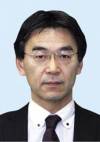 Professor Jiro
Ida, Kanazawa Institute of Technology, Japan. Professor Jiro
Ida, Kanazawa Institute of Technology, Japan.
Status of Fully Depleted (FD) SOI Technology and Prospect of New Super Steep
Cut Off FETs for Ultra Low Power and Harsh Applications.
Abstract: Present status of
SOI device, including ET (extreme thin)-SOI, 3D-FIN, are reviewed. And,
FD-SOI technology which already has been in mass production in Japan is
shown and discussed from view point of device and circuit interaction on
Ultra Low Power Digital, Analog, and RF applications. The capability of
FD-SOI is indicated for expanding Ultra Low power Application. The rad-hard
related projects of JAXA’s (Japan Aerospace Exploration Agency) space
application and KEK’s (High Energy Accelerator Organization in Japan) SOI
pixel detector are also introduced. Finally, the recent topics of the super
steep cut off transistors which S-value is over the theoretical limit,
aiming for the future usage on the ultra low voltage power supply, are
reviewed. And, some data of the steep S-value obtained by floating body
effect in SOI transistor, which is one of the impact ionization MOS (I-MOS),
are introduced.
Bio: Dr. Ida had leaded Logic process integrations and FD-SOI Technology at
OKI Electric Industry Co., Ltd. in Japan. He also had served as a program
committee member of Symposium on VLSI Technology, IEEE international SOI
Conf. and SOI Subcommittee of CMC (Compact Model Council) , and was a
leader, is now an advisory member of Japan PIDS (Process Integration and
Device Structure) Group of ITRS(International Technology Roadmap of
Semiconductor). He moved to Kanazawa Institute of Technology as a professor
in 2009. He has continued R&D on SOI with many partners in Japan and is
interested in device and circuit interaction for ultra low power
applications.
|
|
|
|
Morning Break
|
|
|
|
|
Microsemi
Keynote
 |
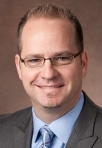 Paul Pickle,
Senior Vice President, Integrated Circuit Group. Paul Pickle,
Senior Vice President, Integrated Circuit Group.
Keynote:
"A New Paradigm: Disruptive SoC Design & Market Strategies."
Paul Pickle, Senior Vice
President, Integrated Circuits Group, Microsemi Corporation. Paul
Pickle has more than 15 years of experience in the electronics industry, and
currently runs Microsemi’s Integrated Circuit Divisions including the
System-on-Chip and Analog Mixed Signal groups. In this role, Paul leverages
the company’s significant design and technical resources in order to
accelerate innovative new customer solutions and market focused product
introductions. He also plays a key role in defining the strategic direction
of the Microsemi, which provides highly reliable, high-performance
semiconductors for defense and security; aerospace; enterprise and
communications; and industrial and alternative energy applications. Since
joining the company in 1998, Paul has held positions of increasing
responsibility including Corporate Vice President of Field Applications
Engineering, and senior positions in both sales and marketing/product
development. Paul’s previous positions include Director of Marketing for GMT
Microelectronics Corporation, and engineering positions with All American
Semiconductor. He holds a Bachelor of Science in Mechanical Engineering
degree with an emphasis on electronics and controls from the University of
South Florida - College of Engineering in Tampa, Florida.
|
|
|
|
Panel |
Panel:
3D: Where are we today; Where are we going; and How will you get there with
us?
|
|
|
|
Panel
Xilinx
EDA2ASIC EDA360
Cadence Design Systems
Broadcom
eSilicon
MonolithIC 3D |
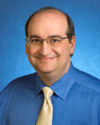 Steve
Leibson, EDA360 Evangelist. Steve
Leibson, EDA360 Evangelist.
Moderator
Bio: Steve Leibson literally
wrote the books on IP-based SOC design — “Designing SOCs with Configured
Cores,” published in 2006 and “Engineering the Complex SOC,” co-authored
with Dr. Chris Rowen and published in 2004. Steve has been evangelizing
IP-centric SOC design since 2001 through articles, White Papers, books and
book chapters, Webinars, videos, invited keynote presentations, conference
presentations, and in-booth trade show presentations around the world. He is
now the EDA360 Evangelist and Marketing Director at Cadence Design Systems,
a leading EDA vendor specializing in system and chip-level design tools,
design IP and IP design platforms, and verification IP. Prior to joining
Tensilica as Technology Evangelist, he was VP of Content for Reed-Elsevier/Microdesign
Resources, managed and ran the Microprocessor Forum, and he has served as
editor in chief of the Microprocessor Report newsletter, EDN Magazine, and
Embedded Developer’s journal where he set publication vision and mission and
managed editorial and production teams of experienced journalists and
writer/engineers. He has many years of experience in persuasively
communicating with the electronic design community across a broad range of
topics and has made a particular study of reaching the extremely elusive
design community for the purpose of lead generation through diverse channels
including the Internet, blogs, social media, and online video.
Panelists:
1. Herb Reiter, President of
EDA 2 ASIC, 3D consultant to GSA.
2. Samta Bansal, Product Marketing, Applied Silicon Realization, Cadence.
3. Dr. Steve Trimberger, Fellow, Circuits & Architectures Group, Xilinx.
4. Paul Hollingsworth, VP of Strategic Marketing, eSilicon.
5. Dr. Jingyi Zhang works, Broadcom.
6. Zvi Or-Bach, President & CEO, MonolithIC 3D™ Inc.
|
|
|
|
EDA2ASIC
 |
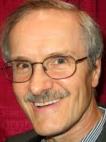 Herb Reiter,
President of EDA 2 ASIC, 3D consultant to GSA. Herb Reiter,
President of EDA 2 ASIC, 3D consultant to GSA.
Panelist.
Bio:
|
|
|
|
Cadence Design Systems
 |
 Samta Bansal,
Product Marketing, Applied Silicon Realization, Cadence. Samta Bansal,
Product Marketing, Applied Silicon Realization, Cadence.
Panelist.
Bio:
|
|
|
|
Xilinx
 |
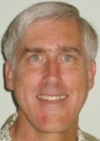 Dr.
Steve Trimberger, Fellow, Circuits & Architectures Group, Xilinx. Dr.
Steve Trimberger, Fellow, Circuits & Architectures Group, Xilinx.
Panelist.
Bio: Dr. Steve Trimberger has been employed at Xilinx since 1988. He is
currently a Xilinx Fellow heading the Circuits and Architectures Group in
Xilinx Research Labs in San Jose, California. He was the technical leader
for the XC4000 design automation software, developed a
dynamically-reconfigurable multi-context FPGA, led the architecture
definition group for the Xilinx XC4000X device families and designed the
Xilinx bitstream security functions in the Virtex families of FPGAs. He has
served as Design Methods Chair for the Design Automation Conference, Program
Chair and General Chair for the ACM/SIGDA FPGA Symposium and on the
technical programs of numerous Workshops and Symposia. He has published
three books and dozens of papers on design automation and FPGA
architectures. He has more than 170 patents in IC design, FPGA and ASIC
architecture, CAE and cryptography. His innovations appear today in nearly
all commercial FPGA devices. He is a Fellow of the ACM.
|
|
|
|
eSilicon
 |
 Paul
Hollingsworth, VP of Strategic Marketing, eSilicon. Paul
Hollingsworth, VP of Strategic Marketing, eSilicon.
Panelist.
Bio: Paul Hollingworth is Vice-President of Strategic Marketing at eSilicon.
Prior to joining eSilicon, he was VP Sales and Marketing at Tier Logic, a
startup developing 3D FPGAs and ASICs. Before this, he was at Altera for 13
years, first managing Marketing for Altera in Europe before moving to the
USA in 2004 as Senior Director of the HardCopy ASIC Group. Prior to that,
Mr. Hollingworth spent 11 years in the ASIC industry, working for LSI Logic
in England and Germany in technical and marketing roles, and at Thesys (now
X-Fab) where he ran the Communications Group. Mr. Hollingworth received a
BSEE in physics and electronics and a Masters in microelectronics and
management from Durham University in England.
|
|
|
|
Broadcom
 |
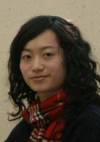 Dr. Jingyi Zhang, Broadcom. Dr. Jingyi Zhang, Broadcom.
Panelist.
Bio: Dr. Jingyi Zhang received the Ph.D. degree in Electrical Engineering
from the State University of New York at Binghamton, NY, in 2010, and is
currently working as a staff scientist in infrastructure and networking
department in Broadcom Corp.
|
|
|
|
MonolithIC 3D

|
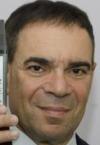 Zvi
Or-Bach, President & CEO, MonolithIC 3D™ Inc. Zvi
Or-Bach, President & CEO, MonolithIC 3D™ Inc.
Panelist.
Bio: Zvi Or-Bach is the founder of MonolithIC 3D™ Inc., a Finalist of the
“Best of Semicon West 2011” for its monolithic 3D-IC breakthrough. Or-Bach
was also a finalist of the EE Times 2011 Innovator of the Year Award for his
pioneering work on the monolithic 3D-IC. Or-Bach has a history of
innovative development in fast-turn ASICs for over 20 years. His vision led
to the invention of the first Structured ASIC architecture, the first single
via programmable array, and the first laser-based system for one-day Gate
Array customization. In 2005, Or-Bach won the EETimes Innovator of the Year
Award and was selected by EE Times to be part of the "Disruptors" --"The
People, Products and Technologies That Are Changing The Way We Live, Work
and Play". Prior to MonolithIC 3D, Or-Bach founded eASIC in 1999 and served
as the company's CEO for six years. eASIC was funded by leading investors
Vinod Khosla and KPCB in three successive rounds. Under Or-Bach's
leadership, eASIC won the prestigious EE Times' 2005 ACE Award for Ultimate
Product of the year in the Logic and Programmable Logic category. Even
before his entrepreneurial ventures in ASIC technology, Or-Bach held
engineering management positions at Elbit Computers, Ltd., Israel
(subsidiary of Elron) and Honeywell (Lexington, Massachusetts). Zvi Or-Bach
received his B.Sc. degree (1975) cum laude in Electrical Engineering from
the Technion - Israel Institute of Technology, and M.Sc. (1979) with
distinction in Computer Science, from the Weizmann Institute, Israel. He
holds over 50 patents, primarily in the field of semi-custom chip
architectures. |
|
|
|
Lunch |
Lunch |
|
|
|
|
Panel:
“Emerging
Technologies, Trends, and Possibilities in Designing Multicore SoC
Platforms.
"
|
|
|
|
Panel
Savant
Company Inc.

Etron
Technology, Inc.
Target Compiler Technologies
Intel
UC
Riverside.
Methodics
Open Silicon
|
 Janice
Ozguc, Technology Market Analyst, Semiconductor Components and IP, Savant
Company Inc Affiliate. Janice
Ozguc, Technology Market Analyst, Semiconductor Components and IP, Savant
Company Inc Affiliate.
Moderator
Bio: Janice Ozguc is a
technology market analysis concentrating primarily on the semiconductor and
IP industries. She has over 25 years of experience in the high tech
industry, principally in the areas of executive management, strategic
marketing, and business development, as well as design engineering and
applications engineering. Prior to establishing her consulting business,
Janice was the VP of Business Development for Octalica, a start up
developing digital media home networking semiconductors. Her involvement in
leading Octalica as part of the four person executive team culminated in a
successful acquisition by Broadcom. She has also held executive marketing
and sales positions within Entropic, another leader in the home networking
space as well as various semiconductor companies including Kawasaki LSI,
U.S.A., IBM Microelectronics and Toshiba America. In addition to working
with Savant, Janice consults for major financial firms, standards bodies as
well as semiconductor and start-up companies. Janice holds an MSEE and
undergraduate degrees from Boston University.
Panelists:
1. Dr.
Philip Brisk, Assistant Professor, Department of Computer Science and
Engineering, UC Riverside.
2. Simon Butler - CEO Methodics.
3. Dr. Dominik Schmidt, Intel.
4. Kurt Prunty, Director of Sales, Target Compiler
Technologies, Inc.
5. Tsu-Chang
(TC) Lee, Ph.D., Chief Strategy Officer, Etron Technology, Inc.
6. Hans Bouwmeester, Open Silicon.
|
|
|
|
UC Riverside
 |
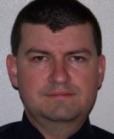 Dr.
Philip Brisk, Assistant Professor, Department of Computer Science and
Engineering, UC Riverside. Dr.
Philip Brisk, Assistant Professor, Department of Computer Science and
Engineering, UC Riverside.
Panelist.
Bio: Philip Brisk received his B.S., M.S., and Ph.D. degrees, all in
Computer Science, from UCLA in 2002, 2003, and 2006 respectively. From
2006-2009, he was a postdoctoral scholar in the Processor Architecture
Laboratory at the Ecole Polytechnique Federale
de Lausanne (EPFL) in Switzerland. Since 2009, he has been an Assistant
Professor in the Department of Computer Science and Engineering at the
University of California, Riverside.
Dr. Brisk's research interests include embedded processor architecture and
customization, FPGAs and reconfigurable computing, compilers, VLSI-CAD,
computer arithmetic, and emerging microfluidic technologies. He has received
best paper awards at CASES 2007 and FPL 2009, and has been nominated for
best paper awards at DAC 2007 and HiPEAC 2010. He is a member of the ACM and
IEEE.
|
|
|
|
Methodics
 |
 Simon Butler -
CEO, Methodics. Simon Butler -
CEO, Methodics.
Panelist.
Bio: Simon Butler is a graduate of the University of Manchester (UMIST) and
has 20 years of engineering experience with IC's. His design/EDA background
includes DSP/FFT processor core development, 64bit MIPS processor
development, x86 methododology consultant, physical floorplanning EDA tools,
mixed signal/analog layout EDA tools. He held various technical lead and
engineering management positions at High Level Design Systems (acquired by
Cadence), Sandcraft, Cadence, Sabio Labs (acquired by Magma), founded IC
Methods LLC in 2000 and co-founded Methodics in 2006.
|
|
|
|
Intel
 |
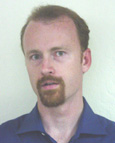 Dr. Dominik Schmidt,
Intel. Dr. Dominik Schmidt,
Intel.
Panelist.
Bio: Dominik Schmidt, M.S.M., Ph.D., PE, has been working in the
semiconductor industry for 20 years. He was at Altera working on
reconfigurable logic and has worked with Sharp, TI, Cypress, and TSMC. He
cofounded Pixel Devices International (PDI) in 1997, one of the first
companies to offer CMOS imaging chips. After PDI was acquired by Agilent, he
founded Airify Communications, specializing in multi-protocol wireless chip
design. After the acquisition of Airify, Schmidt is now at Intel Corporation
leading efforts to design the next generation of advanced wireless products.
He has also worked for the Stanford Linear Accelerator and Lawrence Berkeley
National Laboratory on several advanced projects, and has consulted for
several large companies and startups in the mixed-signal and RF design
areas. He has taught at UC Extension since 2000 and also teaches at Tsinghua
University in Beijing. He is writing a graduate textbook on RF Design for
Elsevier Press.
|
|
|
|
Target Compiler Technologies,
Inc.
 |
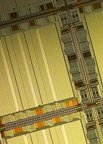 Kurt Prunty,
Director of Sales, Target Compiler Technologies, Inc. Kurt Prunty,
Director of Sales, Target Compiler Technologies, Inc.
Panelist.
Bio: TBA. |
|
|
|
Etron Technology, Inc.
 |
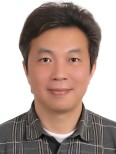 Tsu-Chang (TC)
Lee, Ph.D., Chief Strategy Officer, Etron Technology, Inc. Tsu-Chang (TC)
Lee, Ph.D., Chief Strategy Officer, Etron Technology, Inc.
Panelist.
Bio: Dr. Tsu-Chang Lee received Ph.D. in Electrical Engineering from
Stanford University. The title of his Ph.D. thesis is “Structure Level
Adaptation for Artificial Neural Networks”. As a business professional and
entrepreneur, Dr. Lee has abundant and diversified technology / product /
market / organization development experiences in large, small, and start-up
companies. He is currently serving as Chief Strategy Officer for Etron
Technology, Inc., a fabless semiconductor company providing memory and I/O
IC solutions. He was the founder and CEO for NeoParadigm Labs, Inc.(NPL), a
fabless semiconductor company pioneering in providing many “Interconnected
Multimedia” SoCs including controllers for LCD displays, networking, and
video communications applications. He was Chief Technical Officer for
Silvar-Lisco (also called Silicon Valley Research -SVR), one of the earliest
pioneers in providing EDA S/W tools. He was manager for Structure IC Design
group of Cadence Design Systems. Being a passionate technology
business architect, Dr. Lee is always seeking opportunities to serve and
deliver positive influences into the world. He has also served in many
non-profit organizations. Dr. Lee is currently serving as a Leadership
Council Member for the American Cancer Society - California Chinese Unit, in
which he pioneered the first Relay For Life “in the Cloud” event in 2010, to
connect and share with Chinese communities worldwide.
|
|
|
|
Open Silicon

|
 Hans
Bouwmeester, Director of the ARM® Center of Excellence, Open Silicon. Hans
Bouwmeester, Director of the ARM® Center of Excellence, Open Silicon.
Panelist.
Bio: Hans Bouwmeester is director of the ARM® Center of Excellence and
director of IP for Open-Silicon and is responsible for IP vendor and core
qualification, customer IP selection, and IP integration. Prior to joining
Open-Silicon in January of 2007, he spent 14 years with Philips
Semiconductors in a variety of initial roles including processor development
and IP program management. In 2005 he led a Philips effort to develop
reusable IP building blocks for SoC design. In mid 2005 he became director
of the Eindhoven IC design center responsible for development of a wide
range of products. He has an MSEE degree from Technische Universiteit Delft.
|
|
|
|
Keynote

|
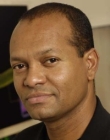 Dr.
Ralph Etienne-Cummings, Professor Department of Electrical and Computer
Engineering. Johns Hopkins University. Dr.
Ralph Etienne-Cummings, Professor Department of Electrical and Computer
Engineering. Johns Hopkins University.
Keynote: “Designing SoC
That Speak The Same Language as the Nervous System."
Abstract: Key barriers to
permanent adoption and continuous use of prosthetic devices are their
limited functionality and incompatibility with natural human actions. E.g.,
standard upper limb prosthetics require retraining of remaining muscles, or
abnormal contortion of remaining parts of the limb to open/close
non-anthropomorphic manipulators. In 2005 a program was initiated by the US
Government to develop an upper limb prosthetic device that would be neurally
integrated to the body. That is, the prosthetic limb would decode the intent
of the user via motor cortex neural recordings, and feedback sensation by
somatosenory cortex stimulation. The lofty goal was to develop prosthetic
arms that were indistinguishable from “native” ones. As can be expected,
despite the quantum leaps of innovation resulting from the program, the
ultimate goal of the project remains to be achieved. There are many reasons
for the elusiveness of the goal, among them is the need to develop
electronics that interface seamlessly with the nervous system, and
communicate with it in the same “spike-based” and “neural encoding”
language. In this talk, I will describe progress on this front, and project
forward to prosthetic devices that will indeed act and feel like native
ones. In the future, Luke Skywalker’s arm in Star Wars: The Empire Strikes
Back, or extendable memory devices as in Johny Mnumonic will become reality
due to developments in neuromorphic engineering.
Bio: Ralph Etienne-Cummings received his B. Sc. in physics, 1988, from
Lincoln University, Pennsylvania. He completed his M.S.E.E. and Ph.D. in
electrical engineering at the University of Pennsylvania in December 1991
and 1994, respectively. Currently, Dr. Etienne-Cummings is a professor of
electrical and computer engineering, and computer science at Johns Hopkins
University (JHU). He is the former Director of Computer Engineering at JHU
and the Institute of Neuromorphic Engineering (currently administered by
University of Maryland, College Park). He was also the Associate Director
for Education and Outreach of the National Science Foundation (NSF)
sponsored Engineering Research Centers on Computer Integrated Surgical
Systems and Technology at JHU. He has served as Chairman of the IEEE
Circuits and Systems (CAS) Technical Committee on Sensory Systems and on
Neural Systems and Application, and was elected as a member of CAS Board of
Governors from 1/2007 – 1/2009. He was also the General Chair of the IEEE
BioCAS Conference in 2008, and serves on its Steering Committee. He was also
a member of Imagers, MEMS, Medical and Displays Technical Committee of the
ISSCC Conference from 1999 – 2006. He also serves on numerous editorial
boards and was recently appointed Deputy Editor in Chief for the IEEE
Transactions on Biomedical Circuits and Systems. He is the recipient of the
NSF’s Career and Office of Naval Research Young Investigator Program Awards.
In 2006, he was named a Visiting African Fellow and a Fulbright Fellowship
Grantee for his sabbatical at University of Cape Town, South Africa. He was
invited to be a lecturer at the National Academies of Science Kavli
Frontiers Program, held in November 2007. He won the 2010 JHU Applied
Physics Lab R.W. Hart Prize for Best R&D Project in Development. He has also
won publication awards, including the 2011 Best Paper Award for IEEE
Transactions of Biomedical Circuits and Systems, 2003 Best Paper Award of
the EURASIP Journal of Applied Signal Processing and “Best Ph.D. in a
Nutshell” at the IEEE BioCAS 2008 Conference, and has been recognized for
his activities in promoting the participation of women and minorities in
science, technology, engineering and mathematics. His research interest
includes mixed signal VLSI systems, computational sensors, computer vision,
neuromorphic engineering, smart structures, mobile robotics, legged
locomotion and neuroprosthetic devices. He has published ~200 technical
articles, 1 book, 9 book chapters and holds 5 patents (plus 2 pending) on
his work in these subjects.
|
|
|
|
Afternoon Break
|
|
|
|
|
|
Analog and Mixed-Signal
Design Trends and Challenges for Low-Power Embedded SoC Platforms
Track Chairman: Dr. Ivo Bolsens, CTO, Senior VP, Xilinx.
|
|
|
|
Keynote
 |
 Dr.
Steve Trimberger, Fellow, Circuits & Architectures Group, Xilinx. Dr.
Steve Trimberger, Fellow, Circuits & Architectures Group, Xilinx.
Keynote: “FPGA are Looking uP.”
Bio: Dr. Steve Trimberger has been employed at Xilinx since 1988. He is
currently a Xilinx Fellow heading the Circuits and Architectures Group in
Xilinx Research Labs in San Jose, California. He was the technical leader
for the XC4000 design automation software, developed a
dynamically-reconfigurable multi-context FPGA, led the architecture
definition group for the Xilinx XC4000X device families and designed the
Xilinx bitstream security functions in the Virtex families of FPGAs. He has
served as Design Methods Chair for the Design Automation Conference, Program
Chair and General Chair for the ACM/SIGDA FPGA Symposium and on the
technical programs of numerous Workshops and Symposia. He has published
three books and dozens of papers on design automation and FPGA
architectures. He has more than 170 patents in IC design, FPGA and ASIC
architecture, CAE and cryptography. His innovations appear today in nearly
all commercial FPGA devices. He is a Fellow of the ACM.
|
|
|
|
|
Analog and Mixed-Signal
Design Trends and Challenges for Low-Power Embedded SoC Platforms
Track Chairman:
Dr. Steve Trimberger, Fellow, Circuits & Architectures Group, Xilinx.
|
|
|
|
National Institute of Advanced
Industrial Science and Technology (AIST)
 |
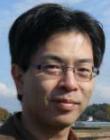 Dr. Shu Namiki,
National Institute of Advanced Industrial Science and Technology (AIST) Dr. Shu Namiki,
National Institute of Advanced Industrial Science and Technology (AIST)
Challenges of Optical Network Technologies.
Abstract: It is without doubt
that the Internet traffic growth nowadays is inseparable from the economic
growth. It is then of general importance for our lives to sustain the
traffic growth for future. On the other hand, the current network
technologies are facing many fundamental limits from physical to transport
layer: the so-called nonlinear Shannon limit; fiber Rayleigh scattering loss
limit; quantum limit of optical amplifiers; electronic devices linewidth
limits; thermal noise limit; TCP bottleneck etc.. And recently, the energy
bottleneck of IP routers is looming due to the rapid penetration of the
broadband access to the Internet. This talk will point out that optical
technologies are the key for sustainable growth of traffic overcoming the
fundamental bottlenecks, while the challenges have yet to be addressed. The
'dynamic optical path network' technologies, recently promoted by authors'
group, are expected to enable the capacity of the network to ever scale
without an energy crunch, circumventing the fundamental limits mentioned
above. As we look at the ingredients of the traffic, the video related
contents are the main driver of the traffic growth, which would be better
served through path provisioning rather than packet processing. Then, the
appropriateness of the optical path switching in conjunction with
space-division multiplexing is discussed in this context. Discussions will
follow to clarify the key enabling technologies for the proposed dynamic
optical path network, and with these technologies given, we will argue that
the total energy consumption could be so low as to avoid the energy crunch
despite allowing sustainable traffic growth.
Bio: Shu Namiki (M’03)
received M. S., and Dr. Sci. in physics and applied physics from Waseda
University, in 1988 and 1998, respectively. He worked for Furukawa Electric
Co., Ltd. from 1988 to 2005, where he developed award-winning high-power
pump laser packaging technologies and next generation devices for optical
networks such as ultrashort optical pulse sources, multi-wavelength-pumped
fiber Raman amplifiers, high performance EDFAs, and nonlinear fiberoptic
devices. He also was a visiting scientist at the Massachusetts Institute of
Technology, from 1994 to 1997, where he studied mode-locked fiber lasers. In
2005, he joined the National Institute of Advanced Industrial Science and
Technology (AIST). He is currently the Team Leader of Optical Signal
Processing Systems Team, Network Photonics Research Center, AIST. He has
performed technical committee duties for most of the prominent international
conferences, such as OFC, ECOC, OAA, CLEO, OECC, COIN, and so forth. He has
also served as Associate Editor for Optics Express and Co-Editor-in-Chief
for IEICE Transactions on Communications, and is currently an Advisory
Editor for Optics Express. Dr. Namiki has co-authored more than 200
conference presentations, papers, book chapters, articles, and patents. He
is an OSA Fellow, and member of IEICE, Japan Society of Applied Physics, and
IEEE Photonics Society and Communications Society.
|
|
|
|
UCLA
 |
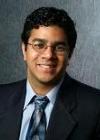 Dr. Sudhakar
Pamarti, Associate Professor, University of California, Los Angeles. Dr. Sudhakar
Pamarti, Associate Professor, University of California, Los Angeles.
The Technological Progress of MEMS-Based Clock Sources.
Abstract: Quartz crystal
based resonators and clocks have, for long, been the unchallenged timing
solutions for the electronics industry. However, in recent years, MEMS based
timing solutions have started offering viable alternatives to quartz at
least in a subset of applications, owing to an innovative combination of
MEMS and IC technologies. This talk will review some of the key innovations
that have led to this growth, and discuss the current capabilities of MEMS
based clocks and outstanding technological challenges.
Bio: Sudhakar Pamarti
received his Ph.D. degrees in electrical engineering from the University of
California at San Diego 2003. Prior to joining UCLA in 2005, he worked with
Rambus Inc. developing high speed chip-to-chip electrical communication
interfaces.
Research: Dr. Pamarti is interested in wireless and wireline communication
system hardware, particularly in mixed signal circuits blocks such as data
converters, frequency synthesizers, and clock synchronization and signal
equalization circuits. His group focuses on developing digital signal
processing and communication theoretic techniques to improve the performance
metrics of error-prone mixed signal circuitry. He emphasizes both the
in-silicon verification and the theoretical analysis of such techniques.
Typical research employs delta-sigma modulation for data conversion,
frequency synthesis and power amplification; or, using CDMA for Gb/s
chip-to-chip communication.
|
|
|
|
Ericsson
 |
 Erdem Karaadam,
Electronics and Communications Engineer. Erdem Karaadam,
Electronics and Communications Engineer.
Practices for Analog and Mixed-Mode Simulations Friendly Design Flow.
Bio: The importance of Analog and Mixed-mode simulations is becoming more
widely recognized with the trend towards multi-IP integration on SoC.
Conventional design flows need to be updated as the capabilities of the
modeling languages and the tool capabilities evolve. The main problems are
how to address the SoC needs and fill in the verification gaps. This article
will propose a way of working with efficient use of modeling languages and
give best practices on the matter.
Abstract: Erdem Karaadam is an
electronics and communications engineer with more than 10 years of
experience and project management skills in the area of Analog/ Mixed-Signal
IC design. He has worked with companies like Alcatel Microelectronics,
STMicroelectronics and STEricsson. He is recently heading the RF/Analog IP
Design Team in Ericsson Microelectronics Design Centre in Istanbul/Turkey.
Erdem is holding BSc and MSc degrees in Electronics and Communications
Engineering, from Istanbul Technical University and Bosphorus University
(Istanbul), respectively.
|
|
|
|
|
Day TWO Nov. 3, 2011
SoC Conference Program Agenda* |
|
|
|
|
Emerging Technologies, Trends, and Possibilities in Designing Multicore SoC
Platforms.
Track
Chairman: Professor Tadao Nakamura, Department of Information and
Computer Science, Keio University, Japan.
|
|
|
|
Savant
Company Inc. |
 Farhad
Mafie, SoC Conference Chairman, Savant Company Inc., President & CEO,
IEEE OC SSCS & OCEN Chairs. Farhad
Mafie, SoC Conference Chairman, Savant Company Inc., President & CEO,
IEEE OC SSCS & OCEN Chairs.
Farhad Mafie is President and
CEO of Savant Company Inc., a technology marketing company in Irvine, CA.
Savant specializes in marketing and sales of semiconductor IC/IP products,
SoC/ASIC services and solutions, as well as providing targeted technical-
and business-related training seminars and conferences globally. He has over
20 years of experience in semiconductor and computer businesses and more
than 10 years of university-level teaching experience. He is the former Vice
President of Marketing and Engineering at Toshiba Semiconductor. He has also
worked in strategic marketing, project and design engineering at Lucent
Technologies, Unisys, and MSI Data. Farhad has a Master of Science and a
Bachelor of Science degree in Electronic Engineering from California State
University, Fullerton. He is an author and a translator, and his articles
have been published in a variety of journals and Web-based magazines on
technology and political affairs. In 2003, he published the biography of
Iranian poet and Nobel nominee who lived in exile, Nader Naderpour
(1929-2000), Iranian Poet, Thinker, Patriot. Farhad is also Editor-in-Chief
for the CRC Press SoC Design and Technologies Book Series, which includes
(1) Low-Power NoC for High-Performance SoC Design and (2) Design of
Cost-Efficient Interconnect Processing Units. Farhad is an active member of
IEEE, and he is the chair of IEEE Orange County Solid-State Circuits Society
(SSCS), as well as IEEE Orange County Entrepreneurs' Network (OCEN). He is
also a member of two UCI Advisory Committees: Communication System
Engineering and Embedded System Engineering Certificate Programs.
|
|
|
|
Octasic
Inc.
 |
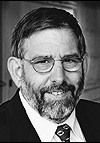
Michel Laurence, Executive Chairman, Founder and CEO, Octasic Inc.
Asynchronous Methodology and Architecture - The Future of SoC Design.
Abstract: New
performance-demanding applications are on the rise and the trend is almost
certain to continue. These applications require significant processing
power, which ultimately translates to more power consumption, a challenge
that has plagued processor design for over a decade. To date, most processor
engineers have had to choose between power and performance when it comes to
designing their products. One way to address this core issue is by using a
self-timed asynchronous architecture. The general characteristics of
asynchronous circuits are extremely appealing and hold the potential to
address many of the key issues (power consumption, process variation, EMI,
etc.) facing processor designers in ever smaller geometries. While much
research has been done over the years in the area of asynchronous circuits,
and many attempts have been made to apply them to various processors, the
results to date have been commercially disappointing. In general those
attempts have suffered from one or more of the following drawbacks:
• the realized performance was equal or less than that of state-of-the-art
synchronous design,
• the silicon cost was significantly higher than the realized gains justify,
• the circuits needed unique and new silicon elements requiring
characterization for reliability at every new process node, and
• the realized processor required new software skills and tools to fully
exploit the advantages.
A new asynchronous architecture has emerged that may hold the key to the
next generation of processor design and manufacturing by meeting and even
exceeding needs in the areas of power and performance. The key to this new
architecture is using proven design techniques in new ways. These techniques
include source-synchronous clocking and innovative static timing tools.
Using this new asynchronous design methodology, processor designers can
achieve a 3:1 improvement in power efficiency over current technologies,
while maintaining the current software programming paradigm. Octasic
has applied this asynchronous technology to a homegrown DSP core, labeled
Opus. Opus 1, the first generation was commercialized in 2008, and serves in
the telecommunications infrastructure market. This year, Opus 2, the 2nd
generation DSP core, is being released to market. This device covers
application spaces including video transcoding and LTE picocells. This
presentation will describe the OCT2224 system on chip. It is composed of 24
Opus2 DSP cores as well as an application processor and associated
peripherals. Video and wireless baseband processing benchmarks will be
presented that show how this DSP Core delivers 3:1 the performance per watt
of any competing DSP core in the same process node. Following this,
the presentation will demonstrate how this asynchronous technology can be
applied to almost any general-purpose CPU and deliver the same 3:1
improvement in power efficiency. The example given will be based on an ARM
A8 implementation. This technology can therefore be applied to a broad range
of processors and applications, ranging from network infrastructure
equipment to application processors for mobile devices.
Bio: Michel Laurence, Executive Chairman, Founder and CEO.
Michel Laurence is a founding member of Octasic. Prior to Octasic, he was
vice president and general manager of the Network Division of Natural
MicroSystems (NMS) in Boston. He joined NMS as a result of its acquisition
of InnoMediaLogic (IML) which he had founded in 1996 and led as CEO into a
thriving multi-million dollar VoP solutions vendor. Previously, Laurence
held various technical management positions in the telecom industry in the
US and Canada. He graduated from the Royal Military College of Canada in
1973.
|
|
|
|
SRS Labs
 |
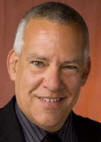 Alan Kraemer,
Chief Technology Officer, SRS Labs. Alan Kraemer,
Chief Technology Officer, SRS Labs.
The Value of Integrating 3D Audio Into SoC Designs.
Abstract: Over the past
year, 3D technologies have taken the CE industry by storm and as a product
of all the buzz created, OEMs and ODMs have been rushing to bring mobile
phones, tablets, PCs and TVs to market with this technology not only to be a
part of the 3D buzz, but so they don’t fall behind the curve. This uprising
of interest in 3D technology presents a unique opportunity to SoC designers
to develop all-inclusive 3D SoC designs that incorporate both 3D visual
processing solutions and 3D audio IP that can then be integrated by OEMs to
deliver the full 3D experience on their products. For this technical
session, I would like to discuss the surround sound paradigm shift, 3D audio
and how it works, why 3D picture only delivers half of the 3D experience,
possible alterations to the SoC architecture to support true
multi-dimensional audio, a few of SRS’ DSP Core partnerships and how through
the incorporation of SRS 3D audio rendering solutions, SoC platform
developers can add value to their design and sell through to more OEMs.
Bio: Alan Kraemer has over 25
years experience in sales and engineering. At SRS Labs, Kraemer has served
in key technology development, most recently as Chief Technology Officer.
Kraemer’s vast audio technology knowledge has helped to establish him as an
audio expert throughout the CE industry. He’s been a featured speaker at
many trade events including: TI Dev Conf. 2007, DisplaySearch Conf. 2007 (2
events), AES 2006, Beijing Digital TV Conf. 2006, Keynote for TI Developer’s
Conf. 2005 (3 countries), CTIA 2004, and many more. Kraemer holds patents
for several SRS technologies and is actively involved in the development of
new audio and voice solutions for the wireless and surround sound markets.
The Value of Integrating 3D Audio Into SoC Designs.
|
|
|
|
ARM
 |
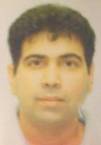 Sachin Idgunji,
Principal Engineer, Research and Development Group at ARM. Sachin Idgunji,
Principal Engineer, Research and Development Group at ARM.
Performance and Efficiency of 3D-Stacked DRAM on Multi-core SoCs.
Abstract: Technology scaling has kept up with Moore’s law allowing the
ability to double the number of transistors in a given area every two years.
At the SoC level , multi-core designs are now the driver in increasing the
performance in systems from mobile processors to high performance servers.
With the shrinking technology nodes, interconnect delay is a key performance
limiter and also results in increased power dissipation from the excessive
repeaters that need to be added to minimize the impact of the delay.
Compounded with the interconnect effect, IOs have not scaled in accordance
and grow at a much lower rate resulting in interfaces that are inefficient.
3D-Integration has been an area of active research to address these
limitations and also offers the capability to increase system integration
through stacking of heterogeneous technologies such as memory stacking on
multi-core SoCs. We present the impact of multi-channel 3D-stacked DRAM on
system performance and efficiency (performance/watt) in such stacked systems
when compared to planar (2D) systems.
Bio: Sachin Idgunji is a Principal Engineer in the Research and Development
Group at ARM. He has been with ARM since 2006 and his current area of
research is in power efficient multi-core system design and is presently
working on projects that investigate the opportunities and challenges of
3D-ICs in multi-core systems on chip (SoC). He has filed and received
patents in areas of low power, fault tolerant circuits and systems and has
worked on various aspects of low power design and how process variation at
advanced nodes impacts SoC design. Sachin received his B.E. in Electronics
Engineering in 1990 from Shivaji University in India and has over 20 years
of industry experience. Prior to joining ARM he held technical lead roles at
Synopsys, IBM, Control Net and PCS-Data General.
|
|
|
|
Keio
University
Japan

|
 Professor Tadao
Nakamura, Department of Information and Computer Science, Keio University,
Japan. Professor Tadao
Nakamura, Department of Information and Computer Science, Keio University,
Japan.
Using the Marching Memory concept to avoid the Memory Bottleneck.
Abstract: Marching memory
integrates all memory including cache memory and some register files into a
single unit to avoid the memory bottleneck. DRAM performance is largely
limited by the need to address and access data from the memory location
furthest from the external pins. Marching memory uses DRAM based memory cell
technology but reorganizes the column and row structure. Marching memory is
organized to synchronize memory columns in minimizing the wire length
between memory cells and the operational units. A side benefit is lower
energy consumption in a smaller packaging format. Marching memory removes
the memory bottleneck by designing a memory so that its access time
corresponds to the cycle time of the executing processor. The basic idea is
to create a memory structure wherein the data is scheduled to arrive at a
fixed physical memory port for immediate use by the processor’s functional
units. Essentially the data comes to the processor rather than the processor
searching randomly for the data.
In its most basic form the Simple Marching memory corresponds to a vector
processor whose data is shifted to the processing pins one column after
another. The Extended Marching memory introduces modes to enable columns to
shift right, left or stay in place. The Complex Marching memory partitions
the entire memory array into units of Extended Marching memory whose outputs
are bussed to the external chip pins. Through this mechanism the Complex
Marching memory achieves a restricted random access.
(based on joint work with Michael Flynn)
Bio: Tadao Nakamura received
his PhD from Tohoku University in 1972. He was a Full Professor at Tohoku
University from 1988-2007, and sent internationally his many PhD graduates
to universities and industries. Seventeen graduates of his are full
professors at universities including an American university. As for Tohoku
University Dr. Nakamura is currently a Professor Emeritus of the university,
and especially in Japan he is also a Professor of Keio University. From
1994-97 he stayed at Stanford University as a visiting Full Professor of the
Electrical Engineering Department, and today he still stays as a visiting
Full Professor at any time if any. In 2007 he was also inducted as a
Professorial Fellow at Imperial College London (The University of London),
and has been making efforts to open his new research laboratory and
environments. His recent research interests are in low-power and high-speed
computer architectures especially with Marching Memory invented by him and
Professor Michael J. Flynn to avoid the memory bottleneck in computer
systems. In 2004 he received The IEEE Computer Society’s Taylor L. Booth
Award. He has been Advisory Committee Chair, after the Organizing Committee
Chair, of COOL Chips conference series fully sponsored by The IEEE Computer
Society. He is an IEEE Fellow.
|
|
|
|
Morning Break
|
Morning Break
|
|
|
|
UCI
 |
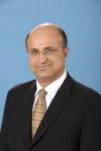 Professor,
Nader Bagherzadeh, UCI, EECS. Professor,
Nader Bagherzadeh, UCI, EECS.
Fault-Tolerance and QoS for Network-on-Chip Based Multicores.
Abstract: In this talk first
an overview of our current work on NoC based multicore architectures is
presented. Next, our current efforts for incorporating fault-tolerance and
QoS onto the current platform is presented. With the potential for using NoC
communication for multicores with 100's cores, it is essential to develop
techniques that handle faults as well as dealing with different priorities
for routing messages.
Bio:
Dr. Nader Bagherzadeh has
been involved in research and development in the areas of computer
architecture, reconfigurable computing, VLSI chip design, and computer
graphics. For almost ten years ago, he was the first researcher working on
the VLSI design of a Very Long Instruction Word (VLIW) processor.
Since then, he has been working on multithreaded superscalars and their
application to signal processing and general purpose computing. His
current project at UC, Irvine is concerned with the design of coarse grain
reconfigurable pixel processors for video applications. The proposed
architecture, called MorphoSys, is versatile enough to be used for digital
signal processing tasks such as the ones encountered in wireless
communications and sonar processing. DARPA and NSF fund the MorphoSys
project (total support $1.5 million). Dr. Bagherzadeh was the Chair of
Department of Electrical and Computer Engineering in the Henry Samueli
School of Engineering at University of California, Irvine. Before
joining UC, Irvine, from 1979 to 1984, he was a member of the technical
staff (MTS) at AT&T Bell Laboratories, developing the hardware and software
components of the next-generation digital switching systems (#5 ESS).
Dr. Bagherzadeh holds a Ph.D. in computer engineering from The University of
Texas at Austin. As a Professor, he has published more than a hundred
articles in peer-reviewed journals and conference papers in areas such as
advanced computer architecture, system software techniques, and high
performance algorithms. He has trained hundreds of students who have
assumed key positions in software and computer systems design companies in
the past twelve years. He has been a Principal Investigator (PI) or
Co-PI on more than $2.5 million worth of research grants for developing
next-generation computer systems for solving computationally intensive
applications related to signal and image processing.
|
|
|
|
Microsemi
 |
 Rich Kapusta,
Microsemi, Vice President, Microsemi. Rich Kapusta,
Microsemi, Vice President, Microsemi.
Customizable SoCs: Two Worlds Collide.
Abstract:
Virtually every embedded system today is implemented using a microcontroller
and some amount of custom hardware, whether in discrete or programmable
form. This is due to the lack of MCUs with the “perfect” feature, which
forces engineers to design around problems with additional components. The
introduction of customizable SoCs solves this problem. cSoCs combine MCU
technology with FPGA and programmable analog, enabling a hardware / software
platform which is infinitely more flexible and substantially more integrated
than any discrete solution on the market today. Using a single cSoC, an
embedded designer no longer has to compromise. Come learn more about this
breakthrough technology.
Bio:
|
|
|
|
Keynote
Purdue University
 |
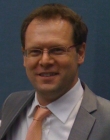 Eugenio
Culurciello Associate Professor of Biomedical Engineering Purdue University. Eugenio
Culurciello Associate Professor of Biomedical Engineering Purdue University.
Keynote: “Vision For Robots, Vehicles And Consumer Electronics: How Close
Are We?”
Abstract: We discuss the
current state of the art in synthetic vision systems for robotics and
consumer applications. We ask and partially answer the following questions:
when will vehicles, consumer electronics, robotic helpers and computing
equipment perform visual tasks that are now only the prerogative of humans?
Where is robotic and artificial vision right now? How close are we to
embedded vision system that perform at the level of humans? When will robot
help our everyday life? We also present the state of the art hardware
systems for embedded vision and discuss their performance in comparison with
general purpose computer processors, graphic cards, programmable hardware
and systems on a chip. We also present the current state-of-the-art work on
neuromorphic hardware models of the mammalian visual system. In particular
systems that model retinal pre-processing and the ventral visual pathway,
with the goal of categorizing, tracking and maintaining a visual memory of
tens of targets. More information can be found here:
http://www.neuflow.org/
Bio: Eugenio Culurciello
(S'97-M'99) received the Ph.D. degree in Electrical and Computer Engineering
in 2004 from the Johns Hopkins University, Baltimore, MD. He is an associate
professor of the Weldon School of Biomedical Engineering at Purdue
University, where he directs the ‘e-Lab’ laboratory. His research interest
is in analog and mixed-mode integrated circuits for biomedical
instrumentation, synthetic vision, bio-inspired sensory systems and
networks, biological sensors, silicon-on-insulator design. Eugenio
Culurciello is the recipient of The Presidential Early Career Award for
Scientists and Engineers (PECASE) and Young Investigator Program from ONR,
the Distinguished Lecturer of the IEEE (CASS), and is the author of the book
"Silicon-on-Sapphire Circuits and Systems, Sensor and Biosensor interfaces"
published by McGraw Hill in 2009.
|
|
|
|
Lunch |
Lunch |
|
|
|
|
Green
Chips: Technologies, Tools, and Methodologies in Designing Ultra Low-Power
Multicore SoCs.
Track Chairman: Dr. Ralph Etienne-Cummings, Professor Department of
Electrical and Computer Engineering, The Johns Hopkins University.
|
|
|
|
AMD
 |
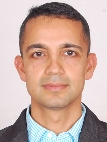 Pankaj Singh, Sr.
Manager – Design Engineering, AMD. Pankaj Singh, Sr.
Manager – Design Engineering, AMD.
Fusion APU and Trends/Challenges in Future Processor Design.
Abstract: In January 2011 AMD introduced
world’s first APU and pointed the world towards a new way of computing. This
was very much a first step in an architectural journey that is well underway
at AMD. In this session the speaker talks about AMD’s innovative Fusion
architecture which provides heterogeneous computing with excellent visual
experience on Graphics. It combines different processing engines in
single-chip to strike a unique balance between the dimensions of
performance, power consumption thereby delivering Outstanding
performance-per -watt-per-dollar. AMD is working to ease the programmer’s
access to this new level of compute horsepower and dramatically expand the
processing resources available to modern applications by Open CL. The talk
highlights benefits of heterogeneous computing and need for open standard
programming language such as OpenCL for general purpose computing on GPU’s.
The convergence of mobility, communication and computing has produced
multifunctional end applications requiring low power, high performance
computing. This talk also presents various challenges faced in next
generation microprocessor SOC development and discusses ways to improve the
productivity and efficiency of SoC design. To improve productivity and
efficiency of SoC’s, various options are discussed such as creating/reusing
higher building blocks, building high B.W and scalable interfaces for high
throughput, 3D stacking to meet high performance, high density and memory
bandwidth requirement.
Bio: Pankaj work with AMD as
Sr. Manager –Design engineering and is responsible for leading SoC
verification activities from India for AMD’s next generation fusion
products. Pankaj completed his Bachelors in Electronics from REC [NIT]
Bhopal in 1993; Master's in Electrical Engineering from USF, Florida and an
MBA from SMU, Dallas. Overall he has 18 years of industry experience of
working with startup's and also large US/European MNC's. His past work
includes various leadership roles such as IP India Design center Manager,
full chip SoC Engineering Manager, Design flow department head with
company's such as GDA (acquired by Rambus), Texas Instruments and Infineon
Technologies. Besides management experience, Pankaj has also published 15
technical papers in various international conferences and has been a board
member of few conference committees.
|
|
| |
EZchip

|
 Patrick
Bisson – VP Product Management, EZchip. Patrick
Bisson – VP Product Management, EZchip.
Challenges and Architecture of a 200-Gigabit Network Processor
Abstract:
100GE target applications
What are NPUs?
Typical router line card
Main NPU functions: Processing, Traffic Management, OAM
Processing challenges at 200Gbps: Required clock cycles, Required I/O
bandwidth, Power
EZchip’s NPU architecture fundamentals
NP-5 is a 200Gbps NPU
Bio: Patrick Bisson joined EZchip in November 2002 as Senior Director of
Technology. Since then, he has played a key role in securing multiple design
wins for EZchip’s products and supporting their deployment in customer
applications. Previously, from 1997 to 2002, he served as Director of
Software Engineering for Siara Systems and Cerent Corporation. His
contribution was instrumental to the acquisitions by Redback Networks and
Cisco Systems respectively. For seven years prior, Mr. Bisson held several
software engineering and management positions at Alcatel. He holds a M.S. in
Computer Science from INSA (Institut National des Sciences Appliquées),
Lyon, France.
|
|
|
|
USC
 |
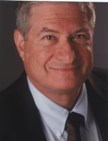 Professor
Melvin A. Breuer, USC. Professor
Melvin A. Breuer, USC.
The Three R’s: Reliability, Redundancy and Reconfiguration.
Abstract: Due to trends in
CMOS scaling and the imminent emergence of new computational fabrics, issues
related to process variations, defects and noise have resulted in large
variations in yield, performance and capability/capacity associated with the
mass production of a given design. In the past, test engineers addressed
many of these issues. But now it appears that the problems are so great, and
solutions proposed by test engineers so costly, that new paradigms are
needed. I will suggest three such approaches in this talk, namely (1) that
design engineers focus on yield with the same intensity that they have given
to logic minimization, high performance and low power; (2) that redundancy
can be effectively used for logic and not be restricted to memories; and (3)
adopt the premise that all complex chips are defective, and high yield is
obtained via identification via diagnosis of circuitry that is functional,
and then reconfigure the circuitry so that a marketable product is realized.
Bio: Melvin A. Breuer received
his Ph.D. in electrical engineering from the University of California,
Berkeley, and is the Charles Lee Powell Professor of Electrical Engineering
and Computer Science at the University of Southern California. He was
Chairman of the Department of Electrical Engineering-Systems from 1991-1994,
and again from 2000-2003. He was Chair of the Faculty of the School of
Engineering, USC, for the
1997-98 academic year. His main interests are in the area of computer-aided
design of digital systems, design-for-test and built-in self-test, and VLSI
circuits. Dr. Breuer is the editor and co-author of Design Automation of
Digital Systems: Theory and Techniques, Prentice-Hall; editor of Digital
Systems Design Automation: Languages, Simulation and Data Base, Computer
Science Press; co-author of Diagnosis and Reliable Design of Digital
Systems, Computer Science Press; co-editor of Computer Hardware Description
Languages and their Applications, North-Holland; co-editor and contributor
to Knowledge Based Systems for Test and Diagnosis, North-Holland; and
co-author of Digital System Testing and Testable Design, Computer Science
Press 1990 and reprinted in 1995 by the IEEE Press. He has published over
230 technical papers and was formerly the editor-in-chief of the Journal of
Design Automation and Fault Tolerant Computing, on the editorial board of
the Journal of Electronic Testing, the co-editor of the Journal of Digital
Systems, and the Program Chairman of the Fifth International IFIP Conference
on Computer Hardware Description Languages and Their Applications. He is a
co-author of a paper that received an honorable mention award at the 1997
International Test Conference, a co-author of a paper nominated for the best
paper award at the 1998 Design Automation and Test in Europe Conf., a
co-author of a paper published in the 1998 International Test Conference
that was selected to be in a compendium of significant papers over the last
35 years, and a co-author of the best paper at the 2000 Asian Test
Symposium. He is a Life Fellow of the IEEE; was a Fulbright-Hays scholar
(1972); received the 1991 Associates Award for Creativity in Research and
Scholarship from the University of Southern California, the 1991 USC School
of Engineering Award for Exceptional Service, the IEEE Computer Society’s
1993 Taylor L. Booth Education Award, an Okawa Foundation Research Grant in
support of research to “Increase the effective yield of VLSI chips via
design and test” (2003), and the first (2000) Engineering Faculty Council
Award for Outstanding Meritorious Service to the USC School of Engineering.
He was the keynote speaker at the Fourth Multimedia Technology and
Applications Symposium, 1999; the Ninth Asian Test Symposium, 2000; the
International Conference on Computer Design (ICCD), 2004; the Annual
Symposium on VLSI (ISVLSI), 2005; the IEEE VLSI Test Symp., 2008, and an
invited speaker at the Thirteenth Asian Test Symposium, 2004. The Test
Technology Technical Council of the IEEE Computer Society hosted a forum on
October 26, 2006 at the Hyatt Regency Hotel, Santa Clara, California to
“celebrate Professor Melvin A. Breuer’s illustrious career and recognize his
contributions to VLSI areas of design automation, design for testability,
fault tolerance and test; and the influence he had on the industry and
academia as an educator and a mentor.”
|
|
|
|
Cavium
Networks
 |
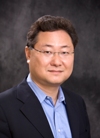 YJ
Kim is the General Manager of the Infrastructure Processor Group at Cavium
Networks. YJ
Kim is the General Manager of the Infrastructure Processor Group at Cavium
Networks.
4G SoC Technology Innovation, from 150Mb UL small cell to 100Gb EPC.
Abstract: With the complexity
and bandwidth requirements of 4G wireless, industry needs a processor family
that can address both compute, throughput, services, power, cost and
scalability as well as full software re-usability top-to-bottom from mobile
access to mobile core network equipment. Cavium will be disclosing
comprehensive 4G Mobile access and core processors and partner solutions for
4G Wireless Carrier segment, including market winning 4G small cell and
macro cell SoCs, 4G LTE Evolved Packet Core/ WiMAX ASN Gateway 100Gb
processors, industry leading 4G Gateway ATCA/ODM platforms and comprehensive
4G wireless software stacks. Will include demonstrations of smallcell and
EPC performances.
Bio: YJ Kim is the General
Manager of the Infrastructure Processor Group at Cavium Networks,
responsible for the OCTEON Multi-core Processor business and product lines.
Since joining the company in June 2006, he has rapidly established OCTEON as
the leader in multi-core solution in wireless infrastructure markets. YJ is
a veteran in the microprocessor and networking industry with over 22 years
of experience. Prior to joining Cavium Networks, Mr. Kim held several key
roles in the industry, including General Manager/Core Team Lead of Tolapai
(IA SOC – EP80579) at Intel Corp, Co-founder/Director at API Networks, a
company that achieved $230M revenue at exit, Marketing Director at Samsung
Semiconductor and various marketing manager positions in the
Westport/IXP2350, Intel x86 Microprocessor and Flash groups. YJ holds a
B.S.E.E. and Master of Engineering in E.E. from Cornell University, and has
attended Wharton Executive Program at University of Pennsylvania.
|
|
| |
Afternoon
Break |
Afternoon
Break
|
|
|
|
UCSD

 |
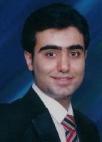 Houman
Homayoun, PhD, NSF-CRA Computing Innovation Fellow University of California,
San Diego Department of Computer Science and Engineering. Houman
Homayoun, PhD, NSF-CRA Computing Innovation Fellow University of California,
San Diego Department of Computer Science and Engineering.
Dynamically Heterogeneous Cores Through 3D Resource Pooling.
Abstract: This work
describes an architecture for a dynamically heterogeneous processor
architecture leveraging 3D stacking technology. Unlike prior work in the 2D
plane, the extra dimension makes it possible to share resources at a fine
granularity between vertically stacked cores. As a result, each core can
grow
or shrink resources, as needed by the code running on the core. This
architecture, therefore, enables run-time customization of cores at a fine
granularity, enables efficient execution at both high and low levels of
thread level parallelism, enables fine-grain thermal management, and enables
fine-grain reconfiguration around faults. With this architecture, we achieve
performance gains from 9-41%, depending on the number of executing threads,
and gain significant advantage in energy-efficiency.
Bio: Houman Homayoun received the PhD degree from the department of
computer science at the University of California Irvine in 2010. He named a
2010 National Science Foundation Computing Innovation Fellow by the
Computing Research Association (CRA) and the Computing Community Consortium
(CCC). He is currently working with Dean Tullsen at UC-San Diego. He
was a recipient of the 4-years UC-Irvine computer science department chair
fellowship. His research is on power-temperature and reliability-aware
memory and processor design optimizations and spans the areas of computer
architecture, circuit design and VLSI-CAD, where he has published more than
30 technical papers on the subject. His research is among the first in the
field to address the importance of cross-layer power and temperature
optimization in memory peripheral circuits. The results of his research were
published in top-rated conferences/journals including DAC, DATE, ISLPED,
ICCD, CASES, HiPEAC, LCTES, and TVLSI. He received his BS degree in
electrical engineering in 2003 from Sharif University of technology, Tehran,
Iran. He received his MS degree in computer engineering in 2005 from
University of Victoria, Canada.
|
|
| |
Movidius
Ltd.

|
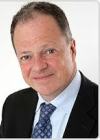 Dr.
David Moloney, CTO, Movidius Ltd. Dr.
David Moloney, CTO, Movidius Ltd.
Greening Multicore –
Maximizing Performance/Watt Embedded Multicore Software Development –
Lessons from the Trenches.
Abstract: Movidius is a
fabless semiconductor company based in Dublin, Ireland and established in
2005. Since inception the company vision was to radically change the
approach to providing multimedia functionality in mobile devices. To date
this approach has consisted on one or more processors augmented by DSP and
fixed-function cores. Having evaluated the available cores and the emerging
multimedia requirements Movidius decided to build a new processor and
multicore architecture optimized from the ground up for power efficiency.
Movidius SHAVE processor is a hybrid stream processor architecture combining
the best features of GPUs, DSPs and RISC with both 8/16/32 bit integer and
16/32 bit floating point arithmetic as well as unique features such as
hardware support for sparse data structures. The architecture is designed to
maximise performance/watt while maintaining ease of programmability,
especially in terms of support for design and porting of multicore software
applications. The resulting architecture offers outstanding performance/watt
across a very broad spectrum of applications from game-physics to 3D HD
video encode on Movidius 65nm Myriad SoC containing 8 SHAVE processors as
well as an on-board 32-bit RISC and numerous programmable peripherals. The
detailed SHAVE architecture as well as unique features will be presented,
along with the SoC implementation details including power optimization and
power-saving features of the Myriad SoC. Results based on silicon will be
outlined in comparison to the state-of-the-art and preliminary. Details of
Movidius software development flow and applications as well as product
roadmap will be outlined.
Bio: David Moloney
received a B.Eng from Dublin City University in 1985, and Ph.D. in
Engineering from Trinity College Dublin in 2010. Since 1985 he worked for
Siemens Halbleiter AG (Infineon) in Munich and ST Microelectronics in Milan
as a DSP IC designer, before returning to Ireland 1994 to co-found a series
of start-up technology companies including Parthus (CEVA) and Silansys
(Frontier-Silicon). David is currently co-founder (2005) and CTO of Movidius
Ltd., a fabless semiconductor company headquartered in Dublin and focused on
the design of software programmable multimedia accelerator SoCs. He holds 18
US patents with many others in process as well as authoring conference and
journal papers on DSP and computer architecture. David is a member of the
IEEE.
|
|
|
|
10 Min
Afternoon Break |
10 Min
Afternoon Break
|
|
|
|
Panel
(FREE for Everyone!)
|
“Technology &
Entrepreneurship: Dreams, Realities & Opportunities”
Open To Everyone
|
|
|
|
Savant
Company Inc.

Netvinci Inc.
Source Scientific
Stetina Brunda
Garred & Brucker.
Hiperwall
Excalibur Engineering
Corporate Finance Associates
|
 Farhad
Mafie, SoC Conference Chairman, Savant Company Inc., President & CEO,
IEEE OC SSCS & OCEN Chairs. Farhad
Mafie, SoC Conference Chairman, Savant Company Inc., President & CEO,
IEEE OC SSCS & OCEN Chairs.
Moderator
Bio: Farhad Mafie is President and
CEO of Savant Company Inc., a technology marketing company in Irvine, CA.
Savant specializes in marketing and sales of semiconductor IC/IP products,
SoC/ASIC services and solutions, as well as providing targeted technical-
and business-related training seminars and conferences globally. He has over
20 years of experience in semiconductor and computer businesses and more
than 10 years of university-level teaching experience. He is the former Vice
President of Marketing and Engineering at Toshiba Semiconductor. He has also
worked in strategic marketing, project and design engineering at Lucent
Technologies, Unisys, and MSI Data. Farhad has a Master of Science and a
Bachelor of Science degree in Electronic Engineering from California State
University, Fullerton. He is an author and a translator, and his articles
have been published in a variety of journals and Web-based magazines on
technology and political affairs. In 2003, he published the biography of
Iranian poet and Nobel nominee who lived in exile, Nader Naderpour
(1929-2000), Iranian Poet, Thinker, Patriot. Farhad is also Editor-in-Chief
for the CRC Press SoC Design and Technologies Book Series, which includes
(1) Low-Power NoC for High-Performance SoC Design and (2) Design of
Cost-Efficient Interconnect Processing Units. Farhad is an active member of
IEEE, and he is the chair of IEEE Orange County Solid-State Circuits Society
(SSCS), as well as IEEE Orange County Entrepreneurs' Network (OCEN). He is
also a member of two UCI Advisory Committees: Communication System
Engineering and Embedded System Engineering Certificate Programs.
Panelists:
1. Bruce Sargeant, Founder, President &
CTO, Source Scientific.
2.
Jeff Greenberg, CEO, Hiperwall.
3.
Eric Tanezaki, Intellectual Property Law Partner, Stetina Brunda
Garred & Brucker.
4. Jauher Zaidi, Chairman & CEO, Netvinci
Inc.
5. Chris LaPlante, Founder & President,
Excalibur Engineering.
6. Peter Heydenrych, Chairman and CEO,
Corporate Finance Associates.
This Panel Is Open To
Everyone . . . Register for FREE Panel Pass
More Updates Coming
Soon . . .
Several Opportunities to Win
various Prizes During this Panel Discussion . . .
Don't Miss Out!
|
|
|
|
Source Scientific.
 |
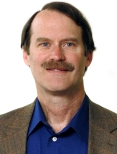 Bruce
Sargeant, Founder, President and CTO of Source Scientific in Irvine. Bruce
Sargeant, Founder, President and CTO of Source Scientific in Irvine.
Panelist
Bio: Mr. Sargeant has over 30 years of engineering product development and
management experience. As a serial entrepreneur, Bruce has founded and
managed five medical/fitness based device companies over the past 31 years.
His companies have developed products such as clinical diagnostic
instruments, ultrasound ablation systems, patient monitors, cardioplegia
pump control systems, pH sensors, and computer controller fitness equipment.
Bruce holds 9 US patents and earned his BSEE from California State
University, Long Beach. He was named its most distinguished alumnus in 1983.
He is currently President and CTO of Source Scientific in Irvine, Calif.
|
|
|
|
Hiperwall
 |
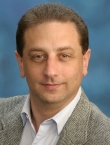 Jeff
Greenberg, CEO, Hiperwall. Jeff
Greenberg, CEO, Hiperwall.
Panelist
Bio: Jeff Greenberg is CEO of Hiperwall, a UCI spinoff whose innovative
software eliminates the cost and complexity of traditional hardware-based
video-wall and distributed visualization systems, while providing additional
unique capabilities. Greenberg has over 25 years of experience in Orange
County’s high-tech community. He holds B.S. and M.S. degrees in computer
science as well as an MBA. In his spare time he teaches entrepreneurship,
serves as Entrepreneur-in-Residence for UCI’s Don Beall Center for
Innovation and Entrepreneurship, and has been published in technology and
business publications like PC Magazine and US News and World Report.
|
|
|
|
Stetina Brunda Garred &
Brucker
 |
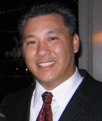 Eric
Tanezaki, Intellectual Property Law Partner, Stetina Brunda Garred & Brucker. Eric
Tanezaki, Intellectual Property Law Partner, Stetina Brunda Garred & Brucker.
Panelist
Bio:
Eric is a partner of Stetina Brunda Garred & Brucker, a boutique full
service intellectual property law firm. He has represented numerous
companies in various industries in relation to patent, trademark and
copyright matters, seeking rights as well as related licensing. He received
his undergraduate engineering degree from the University of Southern
California, and his law degree from the McGeorge School of Law, University
of the Pacific. Prior to law school Eric worked in the aerospace industry.
Eric is the Executive Director of the Southern California Venture Network (SCVN.org).
In addition, Eric is the IP Law Mentor to the USC Stevens Institute for
Innovation. |
|
|
|
Netvinci Inc.
 |

Jauher Zaidi,
Chairman & CEO, Netvinci Inc.
Panelist
Jauher Zaidi is Chairman & CEO of Palmchip
Corporation. Jauher has over twenty years of experience in system
design and integration. Before founding Palmchip in 1996, he was involved in
system-on-chip (SoC) integration at Quantum Corporation. Jauher received his
BSEE and MSEE degrees from Pacific States University in Los Angeles,
California. He has also participated in many SoC panels and is a recognized
expert in the area of SoC development. |
|
|
|
Excalibur Engineering
 |
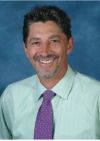 Chris
LaPlante, Founder & President, Excalibur Engineering. Chris
LaPlante, Founder & President, Excalibur Engineering.
Panelist
TBA.
|
|
|
|
Corporate Finance Associates
 |
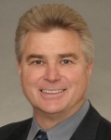 Peter
Heydenrych, Chairman and CEO, Corporate Finance Associates. Peter
Heydenrych, Chairman and CEO, Corporate Finance Associates.
Panelist
Bio: Peter Heydenrych is Chairman and CEO of Corporate
Finance Associates. With more than 20 years experience in corporate finance
and investment banking, including international banking and M&A, he draws on
a depth of experience and brings important insights to bear on the issues
faced by clients. Peter’s entrepreneurial experience, as the owner of both
service and manufacturing companies, provides added perspective and an
enhanced ability to execute successful transactions, serving clients through
a thorough understanding of both the process and the anatomy of M&A
transactions. Most importantly, Peter’s acknowledged capabilities make him a
highly skilled negotiator who is analytical and tenacious, yet objective and
fair. Peter began his work in M&A when, as a Partner and the Managing
Director of one of the largest U.S. architecture firms, he represented the
company in a highly strategic sale to a Fortune 100 company. He transferred
to the acquiring company, and implemented a national roll-up of interior
architecture & design and furniture distribution companies. Peter
joined Corporate Finance Associates in 1991, and was a member of the
management team which completed a buyout of the firm in 1996. He has
participated in numerous M&A and corporate finance transactions,
representing parties wishing to sell, buy or capitalize middle market
businesses. Building on corporate affiliations and M&A experience, Peter has
served the needs of middle-market companies in the technology, health,
business services, transport, telecommunications, manufacturing, financial
services and construction industries. Peter is a Chartered Accountant of
South Africa and holds a Masters Degree in Business Administration from the
University of Cape Town, South Africa. Peter holds FINRA Series 7, 79, 24,
28 and 63 licenses.
|
|
|
|
|
Open To Everyone
Reception
&
Networking
|
|
|
|
|
9th International SoC
Conference Closed.
|
|
|
|
|
|
|
* Program is subject to change.
SoC Conference Organizing Committee, Technical Advisory Board (TAB), and Savant
Company Inc. reserves the rights to revise or modify the SoC Conference program
(the above program) at its sole discretion.
Copyright © 2003-2011 by Savant Company Inc. All
Worldwide Rights Reserved.
Wafer images courtesy of Intel Corporation, Micron Technologies & Altera Corporation.
| |
|